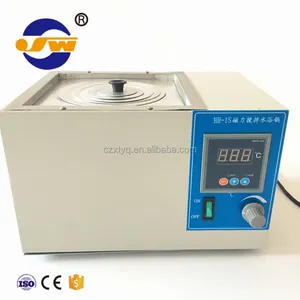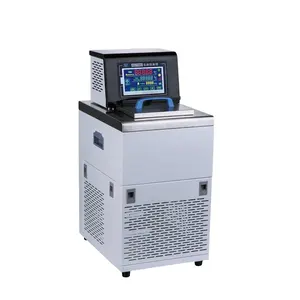

Laboratory Equipment Magnetic Stirring Water Bath

Laboratory Water Bath JOAN Lab Digital Display Thermostatic Water Bath Manufacturer







In the meticulous world of scientific research, the laboratory water bath stands as a silent sentinel of precision. This guide illuminates the pivotal role of water baths in the laboratory, offering a deep dive into their types, applications, and the critical features that make them indispensable. From the gentle thawing of samples to the rigorous demands of molecular biology, water baths provide the controlled conditions necessary for reproducible results. As we explore the diverse options available on Alibaba.com and the key considerations for selection, we prepare to unlock the full potential of these vital instruments in the pursuit of scientific excellence.

A laboratory water bath is an indispensable tool in scientific research, providing controlled heating or cooling of samples. It consists of a container filled with water and includes a thermostat to maintain the desired temperature, which can be adjusted according to the needs of the experiment.
There are several types of laboratory water baths, each serving specific purposes. General purpose water baths are used for basic heating and do not require precise temperature control. Circulating water baths offer uniform temperature distribution, crucial for experiments needing precise temperature maintenance. Shaking water baths provide the additional function of agitation, beneficial for molecular biology experiments.
The benefits of using laboratory water baths are numerous. They provide precise temperature control, ensuring reproducible results. The high specific heat capacity of water allows for uniform heating, eliminating temperature gradients. This versatility makes them suitable for a variety of applications, including sample thawing, solubility tests, and incubation of cultures.

Exploring the variety of laboratory water baths on Alibaba.com reveals a range of devices suited to diverse scientific needs. Among the types available, there are options with precise temperature control, catering to experiments requiring stable heat conditions. Similarly, there are small capacity options for incubation purposes, integrating shaking features for applications that demand both heat and motion.
For larger scale requirements, there are multifunctional devices that can serve as germination chambers and climatic incubators, indicating their versatility in plant sciences. Devices designed for digital precision in temperature regulation are also available, a critical factor for many laboratory procedures.
The range extends to specialized equipment such as multiple station water baths, which provide various stations for simultaneous experiments, optimizing lab efficiency. Additionally, there are portable water bath heaters that showcase the convenience of portability without compromising on the essential feature of thermostatic control. Each type of water bath serves a unique function, from shaking incubators to desk-top versions for space-conscious settings.
When in the market for a laboratory water bath, it's essential to consider several key features to ensure you select a device that meets your specific needs. Temperature uniformity is crucial for consistent sample heating, so look for a water bath that guarantees even temperature distribution. Durability is another important factor, as it dictates the longevity of the equipment. Additionally, overtemperature protection is a safety feature that helps to safeguard your samples and prevent accidents. Ease of use is also a significant consideration; a user-friendly interface can greatly enhance your laboratory experience. While assessing these features, compare different models to find one that aligns with your laboratory applications and provides the precision required for your experiments.
Laboratory water baths serve as a crucial tool in scientific research, providing a stable temperature environment for a variety of experimental procedures. They are instrumental in the warming of reagents, melting substrates, and the determination of boiling points. Their consistent temperature control is essential for incubation processes, particularly in cell culture and enzymatic experiments. The ability to maintain a constant temperature over extended periods makes water baths invaluable for facilitating certain chemical reactions that require high heat. Moreover, their design minimizes the risk of ignition when heating flammable chemicals, making them a safer alternative to open flame heat sources. The versatility of water baths extends to microbiological practices as well, where shaking water baths enable continuous mixing of liquid-grown cell cultures with air, ensuring even distribution of temperature and nutrients.

In the realm of scientific experimentation, precision is paramount, particularly when it comes to the outcomes of experiments. Precision refers to the reproducibility of results, or how closely a series of measurements align with one another. Utilizing precise instruments, such as laboratory water baths, ensures that measurements are consistent, which is crucial for achieving reliable and accurate results. High-precision equipment is typically calibrated to deliver a high degree of accuracy, thereby minimizing errors in measurements and calculations. The pursuit of precision is not merely about using the right tools; it also involves understanding the level of precision necessary for the experiment at hand. For instance, certain analytical procedures, like titrations, demand high precision for determining unknown values, which directly influences the accuracy of the experimental outcomes. The significance of precision is further underscored when considering significant figures in reported values, as they reflect the certainty of the measurements and calculations. In essence, the role of precision in experimental outcomes cannot be overstated, as it is a critical factor that underpins the validity and reliability of scientific research.
When considering the purchase of a laboratory water bath, material and design are crucial for ensuring durability. Water baths are typically constructed from various materials, including stainless steel and plastic. Stainless steel options are generally favored for their longevity, as they tend to be more resistant to the wear and tear of laboratory environments. In contrast, plastic baths may offer a cost-effective alternative but often lack the same level of durability. The choice of material not only impacts the bath's resistance to corrosion and other forms of degradation but also its overall lifespan, which can average from 4 to 6 years and potentially double with proper care. The design of the water bath also plays a role in its durability, with features such as fitted lids and optional racks contributing to its functionality and maintenance. It's important to assess these factors in relation to your budget and the specific requirements of your laboratory tasks.
Utilizing a high-performance laboratory water bath can significantly enhance the precision and reliability of experimental outcomes. These devices are engineered to maintain a stable water temperature from ambient to 100°C, which is crucial for a wide array of lab applications. The capacity to cater to different volume requirements, ranging from 2 L to 28 L, including shallow models, allows for flexibility in experimental design.
The construction of these water baths, with an epoxy powder-coated exterior, offers excellent chemical and corrosion resistance, contributing to their longevity. The seamless stainless-steel interior not only facilitates easy cleaning but also ensures the integrity of the experimental environment. Safety is paramount in laboratory settings, and the over-temperature safety circuitry is designed to prevent thermal runaway, a critical feature that protects both the user and the experiment.
Additional features such as programmable temperature presets, user-adjustable over-temperature alarms, and advanced dry start/run dry protection further underscore the advantages of these sophisticated instruments. The precision of temperature control, with stability and uniformity at ±0.1°C and ±0.2°C respectively, ensures that experiments can be conducted with confidence in the accuracy of the results. The inclusion of intuitive controls and timers enhances the user experience, making these water baths an indispensable tool for researchers seeking to achieve meticulous experimental conditions.
Maintaining a laboratory water bath is crucial to prevent the growth of algae, bacteria, and fungus. Regularly changing the water is a fundamental step, with distilled or deionized water being the preferred choice to avoid mineral buildup and corrosion. To further combat contamination, adding a commercial algicide or biocide is recommended.
The cleaning process should adhere to the manufacturer's manual, avoiding harsh chemicals like bleach and abrasive materials that can damage the bath. Gentle cleaning agents and a soft cloth are usually sufficient. For thorough disinfection, hot water at approximately 140° F can be used to eliminate living contaminants.
An alternative to water in certain types of baths is the use of beads, which can reduce the frequency of cleaning but do not eliminate the need for maintenance. When necessary, beads can be cleaned with ethyl alcohol. Regardless of the method—water or beads—regular cleaning is an integral part of laboratory water bath upkeep.
In conclusion, laboratory water baths are more than just a piece of equipment; they are the cornerstone of precision in experimental science. This guide has traversed the landscape of water baths, from the variety available on Alibaba.com to the essential features and applications that define their use. We've seen how temperature uniformity, durability, and safety features like overtemperature protection contribute to their reliability and how their design influences both functionality and longevity. The role of precision in experimental outcomes has been underscored, emphasizing the importance of high-quality water baths in achieving accurate and consistent results. Finally, we've touched upon the importance of maintenance to ensure the integrity and longevity of these devices. Armed with this knowledge, researchers can make informed decisions to select and maintain a laboratory water bath that meets the exacting standards of their scientific endeavors.